Stif
gamer level 5
3174 xp
3174 xp
followers
9
9
Use my invite URL to register (this will give me kudos)
https://boardgaming.com/register/?invited_by=stif
profile badges

...
...
...
recent achievements

Gamer - Level 5
Earn Gamer XP to level up!
Earn Gamer XP to level up!

Rated 25 Games
Rate 25 games you have played.
Rate 25 games you have played.

Critic - Level 2
Earn Critic XP to level up by completing Critic Quests!
Earn Critic XP to level up by completing Critic Quests!

I Love Playin' Games
Claim that you have played a game today by clicking the "Played Today!" button on a game page 50 times.
Claim that you have played a game today by clicking the "Played Today!" button on a game page 50 times.
Player Stats
Critic (lvl 2)
340 xp
340 xp
Explorer (lvl 3)
768 xp
768 xp
Professor (lvl 1)
230 xp
230 xp
Reporter (lvl 1)
178 xp
178 xp
About Me
I'm a big fan of games where strategy and skill are more important that sheer luck, especially those where bluffing and misrepresenting your position can be key. I also really enjoy a really good co-op game - so it's perhaps no surprise that one of my favorites is Battlestar Galactica which mixes both elements well!
In general I'm happy to play most games as long as they're fun, from classic eurogames like Carcassone and Catan, through quick play card games like the Fluxx series right up to the more meaty experiences like Power Grid or the table-dominating Arkham Horror.
As a father to a one year old boy I've also constantly got my eyes out for games to stockpile ready for him coming of an age when he can join me to play :)
In general I'm happy to play most games as long as they're fun, from classic eurogames like Carcassone and Catan, through quick play card games like the Fluxx series right up to the more meaty experiences like Power Grid or the table-dominating Arkham Horror.
As a father to a one year old boy I've also constantly got my eyes out for games to stockpile ready for him coming of an age when he can join me to play :)






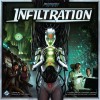


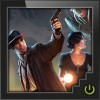











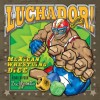



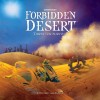




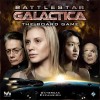

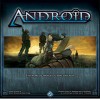

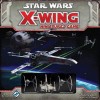





























Zombie Dice
When there is no more room in ****, the dead shall walk the earth… and try to eat your brain, unless you can run away or blast them with a shotgun!
Zombie Dice is a quick to play ‘push your luck’ dice game for, well, any number of players (although I expect more than 4 or 5 would probably be a bit rubbish…). In it, you play a member of the undead horde out for lunch. You want to eat as many brains as you can, chasing down any humans who escape and hoping to avoid catching a shotgun blast to the chest!
Components
The game comes with 13 dice (6 green, 4 yellow, 3 red) and a tub to keep them all in (which can also be used as a dice shaker, if you so wish). Green dice have more brains than shotguns, red dice have more shotguns than brains and yellow are somewhere in the middle.
The quality of these dice is lovely – each are well made, and have brains, footsteps and shotgun blasts embossed on their sides. In short, they roll nicely and look good…not much else to say here!
The dice shaker/tub isn’t quite so nice. It’s just a cardboard tube after all, and the dice do make quite an annoying rattling sound when in it – if you plan to carry the game around with you it’s worth either jamming some cotton wool in there, or getting a wee dice bag to keep the dice in instead.
There’s also a rule sheet…which has the rules on it…
Gameplay
The rules and gameplay of Zombie Dice are incredibly simple – when it’s your turn, you randomly select 3 dice and roll them. Any brains or shotgun blasts rolled are kept and set aside, any footsteps are returned to your hand ready for re-rolling (these represent your victims escaping).
After each roll, you can decide if you want to ‘bank’ any brains you’ve rolled, or if you want to push your luck and keep rolling. If you want to continue, you take any dice which had footsteps and draw additional dice to ensure you have three in your hand – you then roll these.
Then wash, rinse, repeat – simple as that. If at any point you have 3 shotgun blasts it means your victims have got the better of you and your undead self is now all the way dead…so you lose any brains you had collected so far on that turn.
If you decide to stop before this happens, add however many brains you had to your running score and pass the dice to the next player. The game keeps going in this way until one player has reached the target of 13 brains (although once this happens everyone else gets one more roll to see if they can match/beat the score before the game ends and the winner is declared).
Play time
Zombie dice takes about 10 minutes to play, and with a small group it’s great fun. Each turn is over very quickly, so in small groups there’s not too much downtime. Being a quick-fire game it’s usually good for a two or three rounds of play before moving onto something else.
Summary
Zombie Dice is a fun game, that I like to keep in my bag to pull out if I find myself with a short amount of time to fill with friends, and it’s so simple absolutely anyone (well, pretty much…) can pick it up and play it.
I’ve pulled it out for quick plays at game sessions, on train rides and even at work to take a quick break, and it’s always gone down well.
Rating it is difficult – the score I’ve given it is based on it’s cost, simplicity and on the type of game it is…it’s certainly not comparable to a game like Battlestar Galactica, but I still think it’s worth a solid score as I think it’s great value for money (I paid £9.99 for my copy here in the UK) and a great fun wee filler game.
Games move fast and fly by, making this a great game to play either if you find yourself with 20 minutes to spare on a train ride, or whilst another game is being set up for play…and if someone pulls out a copy and you end up not enjoying it, well, it’ll be over in 10 minutes anyway!